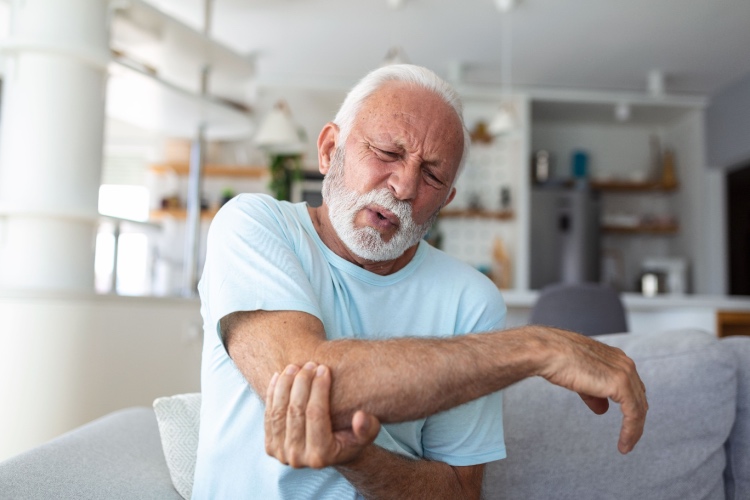
Living with arthritis can transform simple, everyday activities into difficult, sometimes painful tasks. However, there are many ways seniors can modify their routines to minimize joint strain and maintain a more independent lifestyle. From using adaptive tools to altering how daily tasks are performed, seniors can preserve mobility while reducing discomfort.
Table of Contents
- Arthritis in Seniors
- Why Joint Protection Matters for Seniors with Arthritis
- Daily Modifications for Common Activities
- Joint-Friendly Exercises and Movement Tips
- Adaptive Equipment: A Helping Hand for Joint Relief
- Emotional and Mental Health Considerations
- When to Seek Help from a Professional
- Get Support from Blue Moon Senior Counseling
- FAQs
Arthritis in Seniors
Arthritis isn’t just a condition; it’s a challenge that can affect every facet of daily living, particularly for seniors. According to the National Council of Aging, half of older adults in the U.S. have arthritis. With over 100 types of arthritis, two of the most common forms affecting older adults are osteoarthritis and rheumatoid arthritis. Osteoarthritis results from wear and tear on the joints over time, which leads to the breakdown of cartilage, causing pain and stiffness. Rheumatoid arthritis, on the other hand, is an autoimmune disease that causes inflammation in the joints.
Common Symptoms of Arthritis in Seniors:
- Joint stiffness, especially in the morning or after long periods of inactivity
- Swollen, tender joints that may feel warm to the touch
- A decrease in the range of motion in affected areas
- Consistent joint pain, which can vary in intensity
Managing arthritis typically involves a combination of medication, physical therapy, and daily activity modifications. Seniors who understand their specific type of arthritis can better manage their symptoms and make the necessary adjustments to their routines.
Why Joint Protection Matters for Seniors with Arthritis
Joint protection plays a pivotal role in managing arthritis symptoms. Seniors are often unaware that some of their everyday habits may contribute to increased joint strain. For example, bending over frequently, gripping heavy objects, or walking long distances without proper support can all exacerbate joint pain and stiffness.
Why Joint Protection is Crucial:
- Prevents Further Damage: Overworking the joints, especially those already affected by arthritis, can accelerate cartilage deterioration. According to the CDC, avoiding injuries to joints can reduce the chances of getting osteoarthritis or making it worse.
- Reduces Pain: By distributing weight and avoiding repetitive movements, seniors can decrease the amount of pain they experience daily.
- Maintains Mobility: Protecting the joints means seniors can continue performing necessary tasks for longer, retaining their independence.
Joint Protection Strategies:
- Avoid Repetitive Movements: Repetitive motions, like gripping a knife or stirring a pot for long periods, can wear down the joints. Try switching between tasks to avoid overworking any one joint.
- Take Breaks Frequently: Seniors should be encouraged to rest between activities, especially those that involve standing or walking, to allow joints to recover.
Daily Modifications for Common Activities
Modifying how seniors approach daily tasks is crucial for managing arthritis pain. Below are some specific ways to adjust common activities that most seniors perform each day.
Dressing
- Use Adaptive Clothing: Seniors can switch to clothing with elastic waistbands or Velcro fastenings instead of buttons or zippers. This makes dressing quicker and requires less finger dexterity, which is particularly helpful for those with arthritis in the hands or wrists.
- Button Hooks and Zipper Pulls: These tools can be a game-changer for seniors with arthritis. For example, a button hook allows seniors to fasten buttons without the need to use their fingers directly, while a zipper pull gives extra leverage when zipping jackets or pants.
Bathing
- Install Grab Bars: A study found that grab bars significantly reduce the likelihood of falls for seniors with mobility issues. Installing these in the shower or next to the toilet can provide much-needed stability.
- Long-Handled Brushes and Shower Chairs: Using a long-handled bath brush can reduce the need for twisting and bending in the shower, while a shower chair ensures seniors can sit while bathing, eliminating the risk of slipping.
Cooking and Cleaning
- Use an Automatic Jar Opener: Arthritis makes gripping difficult. Automatic jar openers remove the need for strong hands and can make cooking less stressful. Similarly, electric can openers, lightweight utensils, and nonslip mats can all make a significant difference.
- Batch Cooking and Resting Between Tasks: Instead of preparing meals every day, seniors can cook larger quantities of food once or twice a week, storing leftovers for easy access. This reduces time spent standing and straining the joints.
Getting Around the House
- Declutter and Reorganize Living Spaces: Keep commonly used items within easy reach to avoid unnecessary bending or stretching. For example, move frequently used dishes to a lower shelf or use a reacher for high-up items.
- Install Handrails: For seniors living in multi-story homes, handrails can offer stability when navigating stairs. Even in a single-story home, handrails in hallways or by entrances provide additional support.
Joint-Friendly Exercises and Movement Tips
Exercise is often the last thing on a senior’s mind when dealing with arthritis, but gentle movement is critical for maintaining joint function. It helps to strengthen the muscles around the joints, improves flexibility, and can even reduce pain. You can also find a list of programs here for those with arthritis.
Swimming and Water Aerobics
Water-based exercises are a great option for seniors with arthritis because the water supports their weight, reducing pressure on the joints. In the water, seniors can perform a full range of motion without the same risk of injury or pain as on land.
Stretching and Yoga
Simple stretching exercises can reduce stiffness and improve flexibility. Stretching in the morning, for example, can help seniors ease into the day with less pain. Yoga offers the added benefit of mindfulness and relaxation while promoting joint mobility. Poses like the “cat-cow” stretch or “child’s pose” are gentle on the joints but effective.
Strength Training
Using resistance bands or lightweight dumbbells to strengthen the muscles around the joints can help distribute weight and relieve joint pressure. For example, leg lifts or seated arm raises can strengthen the muscles without requiring seniors to put stress on their joints.
Adaptive Equipment: A Helping Hand for Joint Relief
Adaptive equipment is designed to make daily tasks easier for seniors with arthritis. From reaching tools to specialized kitchen gadgets, these devices can significantly reduce the physical demand on joints.
Reachers and Grabbers
These tools extend the range of a senior’s reach, allowing them to pick up items off the floor or from high shelves without needing to bend over or strain their arms. A simple reacher can prevent back strain and reduce joint discomfort when retrieving objects from the ground.
Canes and Walkers
Mobility aids such as canes and walkers can take a significant amount of weight off the joints, particularly for seniors with arthritis in their hips or knees. A properly fitted cane can provide stability, while a walker can assist with balance and weight distribution.
Arthritis Gloves
These gloves apply gentle compression to help reduce swelling and increase circulation, which can alleviate joint pain in the hands. They’re particularly useful when seniors are doing tasks like typing, knitting, or using their hands for extended periods.
Emotional and Mental Health Considerations
Managing arthritis isn’t just about physical adjustments—it’s also about addressing the emotional and psychological toll that chronic pain and mobility limitations can have on seniors. It’s common for seniors to feel frustrated or anxious when their independence is compromised.
Encouraging Open Communication
Seniors may feel embarrassed or discouraged by their physical limitations, but it’s important for them to voice their concerns to family, friends, or caregivers. Keeping the lines of communication open ensures that seniors feel supported emotionally, not just physically.
The Role of Support Groups
Support groups, whether in person or online, can provide a space for seniors to share their experiences and learn from others facing similar challenges. Hearing about others’ successes and struggles can foster a sense of belonging and reduce feelings of isolation.
When to Seek Help from a Professional
While these modifications can help manage arthritis symptoms, sometimes additional professional support is necessary.
In-Home Assistance
If daily activities become too difficult, in-home caregivers can assist with cooking, dressing, bathing, and more. This type of help allows seniors to remain in their own homes without overexerting their joints.
Physical Therapy
Physical therapists can work with seniors to develop exercise programs tailored to their needs. A therapist might recommend specific stretches, strengthening exercises, or mobility aids to improve joint function and reduce pain.
Emotional Counseling
The emotional toll of living with arthritis should not be underestimated. Counseling, especially from licensed therapists like those at Blue Moon Senior Counseling, can help seniors manage their feelings of frustration, anxiety, or depression that may arise from living with chronic pain and reduced
Get Support from Blue Moon Senior Counseling
Seniors with arthritis don’t have to resign themselves to a life of discomfort. By making small but meaningful changes to daily routines, they can protect their joints, maintain their independence, and improve their quality of life. From modifying everyday tasks to incorporating joint-friendly exercises and utilizing adaptive equipment, seniors can stay active and engaged with less pain.
At Blue Moon Senior Counseling, we understand the challenges of living with arthritis. Our team of compassionate therapists is dedicated to providing emotional support and counseling services that help seniors navigate life’s physical and emotional challenges. If you or a loved one is struggling with arthritis, we’re here to help.
Contact us today to learn more about how our telehealth services can support seniors in managing arthritis and living life to the fullest.
FAQs
-
What’s the best way to reduce strain while dressing with arthritis?
Using adaptive clothing with Velcro, elastic bands, or zippers can help. You can also use a button hook or zipper pull to fasten clothing without overusing your finger joints.
-
Are there specific exercises that can help with arthritis?
Yes! Gentle exercises like swimming, yoga, and stretching are great for keeping joints mobile without causing strain. Walking and using resistance bands can also help build muscle support around the joints.
-
How can adaptive equipment like grabbers help reduce joint strain?
Grabbers and reachers extend your reach without requiring you to bend down or stretch your arms, reducing the strain on your back and joints.
-
When should a senior with arthritis seek professional help?
If daily activities become too painful or difficult, seeking help from a physical therapist or hiring in-home assistance can make a big difference. Counseling can also help with the emotional strain arthritis can bring.
-
How can emotional support help seniors with arthritis?
Support groups, counseling, and open communication with loved ones can reduce feelings of frustration, isolation, and depression, helping seniors manage both the physical and emotional challenges of arthritis.
